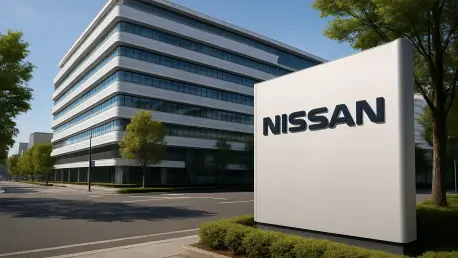In a landscape where the automotive industry faces relentless challenges, Nissan Motor Corp. stands at a critical juncture with a staggering 115.8 billion yen ($782 million) loss reported for the April-June quarter, coupled with a nearly 10% sales drop to 2.7 trillion yen ($18 billion). This dramatic financial downturn paints a troubling picture for a company once celebrated for innovations like the Leaf electric car. As the Yokohama-based automaker navigates this crisis, industry watchers are keenly observing whether new leadership can steer the company back to profitability. This roundup gathers diverse perspectives, insights, and strategies from various industry voices to explore Nissan’s potential for recovery and the broader implications for global manufacturing.
Financial Struggles and the Road to Recovery
Unraveling the Depth of Nissan’s Losses
Nissan’s recent financial reports have sent shockwaves through the industry, with a shift from a 28.6 billion yen profit in the same quarter last year to a massive loss today. Many industry analysts point to declining sales across key markets as a primary driver, compounded by unfavorable currency exchange rates that have eroded global revenue streams. This consensus highlights the urgency for Nissan to address not just the numbers but also the underlying market dynamics at play.
Beyond internal metrics, external pressures such as geopolitical tariffs, particularly those influenced by policies under President Donald Trump, have been flagged as significant hurdles. Some market observers argue that these external factors weigh heavier than internal missteps, creating a perfect storm for the automaker. The complexity of these challenges suggests that a multifaceted approach is essential for any meaningful turnaround.
Despite the grim figures, a sliver of optimism emerges from Nissan’s own assessment that the quarterly results surpassed internal forecasts. Certain industry commentators interpret this as a sign that the company may have a firmer grip on its challenges than public perception suggests. This perspective fuels discussions on whether strategic adjustments already in motion could lay the groundwork for a rebound.
Leadership Transition and Strategic Vision
The appointment of Ivan Espinosa as president in April, following the exit of Makoto Uchida amid fiscal underperformance, has sparked varied reactions among industry stakeholders. With two decades of experience at Nissan, Espinosa is seen by many as a seasoned insider capable of navigating the company through turbulent waters. His early initiatives, including aggressive cost-cutting and market strategy recalibrations, have drawn cautious optimism from some quarters.
However, not all feedback is uniformly positive, as certain analysts express concern over the pace of change under Espinosa’s leadership. The risk of workforce reductions causing internal friction or dampening morale is a recurring theme in discussions, with fears that rapid reforms might alienate key talent. Balancing efficiency with employee trust remains a critical tightrope for the new president to walk.
On the flip side, examples of early success, such as robust sales of the N7 model in China and the Magnite in Mexico, are cited as proof of Espinosa’s targeted approach to regional markets. Industry voices advocating for patience argue that these wins could signal the beginning of a broader recovery if sustained. The debate continues on whether his long-term vision will align with the competitive demands of an evolving automotive sector.
Restructuring Plans and Industry Shifts
Nissan’s bold restructuring moves, including the planned closure of the Oppama factory by the end of the 2027 fiscal year and a global workforce cut of 15%—equating to roughly 20,000 jobs—have elicited a spectrum of opinions. Proponents of these measures within the industry view them as necessary steps to streamline operations and reduce overhead costs in a highly competitive market. The relocation of production to another facility in southwestern Japan is often highlighted as a pragmatic cost-saving tactic.
Conversely, skepticism abounds among some market analysts who question whether slashing jobs and facilities alone can secure Nissan’s future. They emphasize that innovation, particularly in the electric vehicle space, must accompany such cuts to keep pace with rivals who are rapidly advancing in technology. This viewpoint underscores the need for Nissan to invest in forward-thinking solutions rather than relying solely on austerity.
Additionally, the company’s decision to pivot away from a joint holding company with Honda while maintaining technology collaborations has sparked debate. Some industry perspectives suggest that this selective partnership approach allows flexibility to address specific needs, whereas others warn that it might limit deeper synergies. How Nissan balances these strategic shifts with emerging industry trends remains a focal point of discussion.
Global Alliances and Economic Barriers
The interplay between Nissan’s partnerships and geopolitical challenges is another area drawing diverse insights. Tariffs and currency fluctuations are frequently cited as persistent barriers to profitability, with many industry watchers noting that these factors disproportionately impact global players like Nissan. The consensus leans toward the need for adaptive strategies to mitigate such external risks.
Comparing Espinosa’s vision of sustainable growth with approaches taken by industry peers, some analysts believe that streamlined operations could indeed offset these setbacks if paired with robust market expansion. Others, however, caution that without deeper alliances or access to untapped markets, Nissan might struggle to regain its footing. These contrasting views highlight the delicate balancing act required for long-term stability.
Speculation on future pathways also varies, with certain industry opinions favoring stronger collaborations as a potential lifeline amid uncertainty. Exploring new regional opportunities or doubling down on existing partnerships is often suggested as a way to diversify risk. The ongoing dialogue reflects a shared recognition that Nissan’s global strategy must evolve to address both economic and competitive pressures.
Key Takeaways from Industry Perspectives
Synthesizing the range of insights, Nissan’s financial woes, marked by a significant quarterly loss and sales decline, remain a central concern across discussions. Espinosa’s urgent recovery agenda, characterized by cost reductions and market adjustments, garners both support and scrutiny from various corners of the industry. The blend of internal restructuring with external challenges like tariffs forms a complex puzzle that the automaker must solve.
Strategic recommendations emerging from these perspectives include prioritizing innovation in electric vehicles to stay relevant amid industry shifts. Targeted expansion into high-growth markets is also frequently advised as a means to bolster revenue streams. These suggestions reflect a collective belief that recovery hinges on blending efficiency with visionary growth.
For stakeholders keen to track progress, monitoring Nissan’s quarterly updates and evaluating the tangible impact of leadership decisions are practical steps often highlighted. Keeping an eye on how regional successes translate to global outcomes is another recurring tip. Such actions can provide clarity on whether the company is truly on the path to stability.
Final Reflections on Nissan’s Journey
Looking back, the discourse surrounding Nissan’s challenges revealed a tapestry of concern, hope, and strategic critique from industry voices. The depth of financial losses and the boldness of restructuring efforts under new leadership were thoroughly debated, with varied opinions shaping a nuanced understanding of the automaker’s plight. External pressures and internal decisions alike were dissected for their roles in shaping the current state.
Moving forward, stakeholders might consider delving deeper into industry reports and analyses to stay abreast of Nissan’s evolving strategies. Exploring case studies of other automakers who navigated similar crises could offer valuable lessons. Ultimately, the focus should remain on tracking how innovative leaps and market adaptations unfold, as these will likely determine whether Nissan can reclaim its standing in the global arena.









